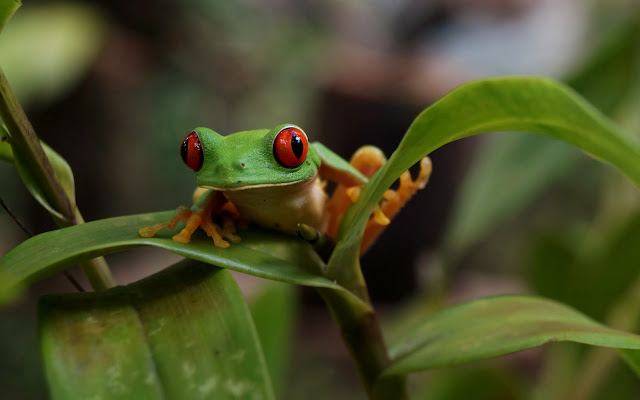Wildlife at Estación Biológica Tamandúa
Up until now, our travel has mostly focused around culture,
food and activities so Estación Biológica Tamandúa was the first place we went herping
(looking for reptiles and amphibians) and wildlife watching properly.
Therefore, here follows a blog post purely about wildlife!
Birds in particular,
are extremely diverse in Central America. Unfortunately, Greg and I
are not bird experts and our interests mostly lie in reptiles and
amphibians. However, I think we both appreciate birds a lot more now.
A common feature of Estación Biológica Tamandúa, was the
hummingbirds which flittered around the flowers planted around the
buildings. We did not realise how angry, noisy and territorial
hummingbirds are. We would constantly hear angry squeaks and a sound
like a hover craft and a pair of hummingbirds would chase each other
through the room, close to colliding with our heads. The hummingbirds
were also extremely inquisitive. They would fly towards us and hover
at eye level for a few seconds, checking us out. They would also do
the same thing with the bathroom mirror. Unfortunately this did
result in one casualty which we found when we returned from the town.
We watched with morbid fascination while the hummingbird was devoured
by ants who tried to take it into their nest.
 |
| Cane Toad under the table |
Another common
feature, was the nightly influx of cane toads and Incilius into the
main building while we ate dinner. As bugs are attracted to light,
the toads were attracted to the bugs. Every evening we would be
joined by toads of various sizes and would enjoy watching them eat
huge beetles or miss their target and headbutt the wall with a load
“thunk”.
Tamandua has a small
resident population of Phyllobates vittatus, the Golfo Dulce
Poison Frog. Recognised as “Endangered” on the IUCN Red List, P.
vittatus occurs only in South
Western Costa Rica and populations are extremely fragmented. At
Tamandua, the frogs are regularly
encountered next to a waterfall in a rocky cave, or on the hill side
and can be heard calling. We encountered P. vittatus
several times an on one
occasion, I witnessed a pair under the bench, calling to each other.
 |
| Pair of Phylobates vittatus |
 |
| Taking photos of frogs isn't always easy! Phylobates vittatus escaping. |
Another poison frog
we encountered was the Rainforest Rocket Frog, Silverstonei
flotator. This frog was
extremely common along all the paths, although extremely fast! We
also found its’ mimic the Striped
Rocket Frog, Allobates talamancae,
which looks very similar but
cannot produce poison.
Contrary to our
expectations, we did not see many snakes. Apparently, in this
location, snakes are more abundant during the dry season. When the
rainy season begins, the rivers begin to flood and the snakes move
away from the rivers into the forest and are hard to find.
 |
| Silverstonei flotator- Rainforest Rocket Frog |
 |
| Leptodeira septentrionalis hunting Smilisca sordida (bottom) |
Leptodeira
septentrionalis, the cat eyed snake, however, was extremely
abundant. If we ventured down to the river after dark, it was normal
to find two individuals foraging for frogs and tadpoles.
They also ventured
into the main building on a few occasions. One time almost ended in
disaster as, unnoticed for a whole morning, the L. septentrionalis
had taken refuge under a heavy table we had to move. Seeing the snake
underneath as we moved the table, I assumed we had killed it and had
about given up, when the snake crawled out onto the floor, unharmed
but pretty pissed off! We also discovered a Yellow-belly Snake,
Coniophanes fissidens passing
through the garden one evening.
 |
| Coniophanes fissidens- Yellow Belly Snake |
One of the snakes we
expected to find lots of was Bothrops asper, the
Fer de Lance. These are commonly found around the research station.
However, in the entire 1.5 months we were there, we only saw 2
individuals, both juveniles. One we spotted in a tree about 6ft high
above the path. B. asper in Costa Rica is commonly called
Terciopelo but has many other names such as Fer de Lance and Barba
Amarilla (in Guatemala). Having extremely toxic venom, a bite from a
Bothrops can be very severe and causes necrosis, requiring
rapid treatment with antivenom to prevent tissue loss or even death.
Being so far from a hospital (probably more than 4 hours by foot,
quad, boat), we had already made the easy decision to not handle any
snakes which we could not identify first. We had also decided to
minimise disturbance of snakes by not handling unless necessary. Most
of the time, the best photos are in-situ and most snakes we found
would freeze in position, allowing time to take photographs.
 |
| Juvenile Bothrops asper 6ft up a tree |
On my birthday we
decided to go out for a longer walk than usual to find waterfall
number 4.
We walked our normal
route beside the river and then continued past our normal waterfall.
We climbed the side of the valley up a zig-zag path and reached the
spine of the hill. We stopped to look at a frog which turned out to
be a small Craugaster fitzingeri. We continued but a second
later a spotted a snake moving rapidly across the path. Immediately
recognising its diamond pattern, I shouted “Snake… Looked like a
Bothrops!” Greg replied “It IS a Bothrops!” The
juvenile Bothrops asper had moved off the path and taken
shelter under a small pile of leaves, but still in plain site. I took
some photos of it before we left it to continue on its way.
 |
| Juvenile Bothrops asper |
 |
| Dermophis occidentalis |
We didn’t actually
make it to waterfall 4- the path had collapsed. On our return, we had
just passed the place we saw the Bothrops, when Greg spotted
something on the path. A caecilian! Unfortunately it was dead,
however, it is very rare to find them as they are fossorial and are
usually found when digging mud. We don’t know why this one was
dead- there were no signs of trauma on its body. Even so, it was a
very exciting sight for us as we have never seen a wild caecilian
before.
Continuing back, we started our descent along the steep zigzag path, when Greg saw a snake shoot out from the undergrowth and freeze just off the path. This enabled me to get some good photos and we identified the snake as Mastigodryas melanolomus, a species found throughout Central America.
 |
| Can you see it? |
 |
| Mastigodryas melanolomus Salmon-bellied Racer |
All in all, my
Birthday was an exceptional day for herping!
With not much to do,
and generally using candle light after dark, our circadium rythums
kicked in and we got into a routine of feeling sleepy after dark.
Unfortunately, herping is best after dark and this meant we didn’t
get out as much as we had expected.
One evening, we were
feeling a little tired and decided to take a short walk along the
path by the river to the river crossing to the rest of the trails. We
walked steadily, looking at frogs and Greg clambered down into the
river to look for the giant Savages Bull Frogs that live in holes
along the river. Just before we reached the crossing, I looked down
and spotted a snake in the undergrowth. I recognised the extremely
thin body and bubble-like head with large eyes as a member of the
Imantodes genus (Imantodes inornatus). We had
encountered Imantodes in Guatemala a few years before and knew
from experience that these are extremely cool, calm snakes. I shouted
to Greg, who attempted to climb up an 8ft bank out of the river.
Thankfully, the snake was perfectly happy slithering around the
knee-high vegetation and showed no signs of stress as we took photos
of it.
 |
| Immantodes inornatus- Western Tree Snake |
On our final week,
we decided to go out for our last long night walk. Taking a path we
had only walked in the day, the Camino Publico, we headed up the
hill, away from the river. Continuing along the path slowly, we kept
an eye out for any odd shapes or reflections that could indicate an
animal. Looking up suddenly, I saw a bright object in a tree above
our heads. It turned out to be Bothreichis schlegelii,
the Eyelash Viper, one of our
target species that we most wanted to see. As it was about 8-9ft
above the path, we didn’t get great photos. This was a brilliant,
positive note to finish our trip on!
 |
| Bothriechis schlegelii- Eyelash Viper |
Finally, thank you
to Estación Biológica Tamandúa for the brilliant opportunity and
experience we had. If anyone else fancies seeing any of the cool
animals we saw, check out their website and book a trip!
Thanks for reading!
Bryony
Total species
list
35 Herps in total!
Amphibians
Frogs and toads- 18
species
Agalychnis
calidryas Red Eyed Tree Frog
Craugastor
crassidigitus Slim-fingered Rain Frog
Craugastor
fitzingeri Common Rain Frog
Diasporus
diastema Common Dink Frog
Engystomops
pustulosus Tungara Frog
Espadarana
prosoblepon Emerald Glass Frog
Sachatamia
albomaculata Cascade Glass frog
Hyalinobatrachium
valerioi Reticulated Glass Frog
Teratohyla
pulverata Dusty Glass Frog
Hypsiboas
rosenbergi Gladiator Tree Frog
Incilius
aucoinae Pacific Forest Toad
Leptodactylus
savageii Central American Bull Frog
Phylobates
vittatus Gulfo Dulce Poison Dart Frog
Rhinella
marinus Cane Toad
Silverstonei
flotator Rainforest Rocket Frog
Allobates
talamancae Striped Rocket Frog
Smilisca
phaeota Masked Tree Frog
Smilisca sordida
Drab Streamside Tree Frog
Salamanda- 1 species
Bolitoglossa
lignicolor Wood-colored Webfoot Salamander
Caecilian- 1
species
Dermophis
occidentalis
Reptiles
Lizard- 9 species+
Basiliscus
basiliscus Common Basilisk
Holcosus
leptophrys Delicate Ameiva
Holcosus
quadralineatus Four-lined Ameiva
Mabuya
unimarginata Central American Mabuya
Leposoma
southi Northern Spectacled Lizard
Norops
biporcatus Giant Green Anole
Norops
limifrons Slender Brown Anole
Norops
polylepis Jumping Anole
Sphaerodactylus
graptolaemus Costa Rica Least
Gecko
Snake- 6 species
Bothrops asper
Terciopelo/ Fer de Lance
Bothriechis
schlegelii Eyelash viper
Leptodeira
septentrionalis Northern Cat-eyed Snake
Immantodes
inornatus Western tree snake
Mastigodryas
melanolomus Salmon-bellied Racer
Coniophanes
fissidens Yellow-belly Snake
 |
| Bolitoglossa lignicolor, Wood-colored Webfoot Salamander |
 |
| Metamorph glass frog sp. |
 |
| Hyalinobatrachium valerioi Reticulated Glass Frog |
 |
| Leposoma southi, Northern Spectacled Lizard |
 |
| Sachatamia albomaculata, Cascade Glass frog in amplexus |
 |
| Leptodeira septentrianalis eating a toad (likely Incilius aucoinae) |
 |
| Hypsiboas rosenbergi Gladiator Tree Frog |
 |
| Teratohyla pulverata, Dusty Glass Frog |
 |
| Teratohyla pulverata eggs |
 |
| Leptodactylus savageii, Central American Bull Frog |


Comments
Post a Comment